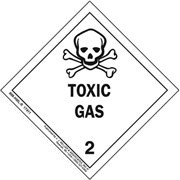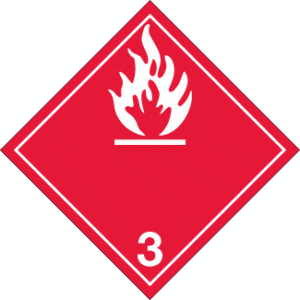39 the class or division hazard labels indicate
Understanding HAZMAT Placards - ArcBest They'll also have the number 1 to indicate the class. Red Red is for flammable goods like gasoline, rubbing alcohol, paint and acetone, which can fall into Classes 2 or 3. These placards feature a flame image and usually have the words flammable, gasoline, combustible or fuel oil. Green Dangerous goods classes and hazard labels - Civil Aviation Safety Authority Below are the 9 hazard labels for the 9 classes of dangerous goods. Class 1 Explosives Class 1 explosives This includes items such as: explosive substances pyrotechnic devices ammunition fireworks detonators. Class 2 Gases Class 2 gases These can be transported as compressed, liquefied, refrigerated liquefied or gas in solution.
Dangerous Goods Shipping Job Aid - FedEx Ensure that labels are readily visible and not obscured or overlapped at all by any of the packaging or by any other label. b. Hazard Labels: • Labels identifying the primary and subsidiary hazards of the dangerous goods must bear the class or division number (IATA 7.2.3.2). c. Handling Labels: • The Cargo Aircraft Only label must be used
The class or division hazard labels indicate
Hazardous Materials Segregation Table from Labelmaster (1) The absence of any hazard class or division or a blank space in the table indicates that no restrictions apply. (2) The letter "X" in the table indicates that these materials may not be loaded, transported, or stored together in the same transport vehicle or storage facility during the course of transportation. CHAPTER 7 - RECALL ACTIVITIES indicate the relative degree of health hazard presented by the product being recalled. 7.1.1.2.1 - CLASS I RECALL . Class I Recall is asituation in which there is … Class 1 Dangerous Goods Explosive Substances and Articles Division 1.5: Very insensitive substances which have a mass explosion hazard; Division 1.6: Extremely insensitive articles which do not have a mass explosion hazard; Class 1 Dangerous Goods Examples & Labels. Commonly transported Class 1 Dangerous Goods include ammunitions, fireworks, air bag inflactors and fuse, etc. Class 1 Dangerous Goods Label
The class or division hazard labels indicate. en.wikipedia.org › wiki › GHS_hazard_pictogramsGHS hazard pictograms - Wikipedia Division 1.2: Substances and articles which have a projection hazard but not a mass explosion hazard Division 1.3: Substances and articles which have a fire hazard and either a minor blast hazard or a minor projection hazard or both, but not a mass explosion hazard. Note: The asterisks are replaced by the class number and compatibility code Hazmat Placards and UN Numbers: What You Need to Know Hazmat warning placards are broken down into nine different classifications, along with their divisions. Each class number is found at the bottom of the sign, while the division number can be found in the middle. Class 1 — Explosive Materials 1.1: Products with the potential to create a mass explosion Classes 1-9 of dangerous goods explained Class 1 Explosive substances and articles Class 1 contains substances and articles which pose a hazard due to explosion. Items in Class 1 are further divided into divisions 1.1 - 1.6 depending on the nature of the explosion hazard and the sensitivity of the item. A compatibility group, consisting of a single letter, is also assigned to each item. The MSDS HyperGlossary: Hazard Statements Hazard statements provide standardized wording to indicate the hazards of a product including, when appropriate, the degree of the hazard. The GHS also has Precaution Statements which provide standardized precaution wordings. You will usually find both P- and H-statements on a label or Safety Data Sheet. In the European Union, H-statements have replaced Risk phrases …
GHS Hazard Classification: Everything You Need to Know A chemical will have a hazard class, and within that class are several hazard categories, of which one or more will apply. Section 2 of the new GHS Labels and SDSs require hazard statements which are determined by assigning a hazard class and category. As a manufacturer, importer, or distributor you'll need to know how to classify hazards. Hazard Classes and U.N. Markings - Hazmatpac The International Maritime Organization (IMO) classifies dangerous goods into nine hazard classes. Diamond labels denote the hazards involved by means of colors and symbols. C. Some hazard classes are further subdivided into hazard divisions due to their wide scopes. There are nine (9) hazard classes. Their order does not indicate degree of danger. DOT Hazard Classes - IAFC Placards are used to identify the class or division of a material. The hazard class or division number must be displayed in the lower corner of a placard and is required for both primary and subsidiary hazard classes and divisions, if applicable. Transportation of Dangerous Goods (TDG) - Classification When test results and the hazard class criteria are compared, there are three possible conclusions: a) The laboratory test results show the product does not meet any of the criteria for the hazard classes. In this case, the product is not TDG regulated and the product does not need to comply with the TDG Regulations.
› title8 › 5194California Code of Regulations, Title 8, Section 5194. Hazard ... Sep 28, 2018 · (1) This section requires manufacturers or importers to classify the hazards of chemicals which they produce or import, and all employers to provide information to their employees about the hazardous chemicals to which they may be exposed, by means of a hazard communication program, labels and other forms of warning, safety data sheets, and information and training. DOT Hazard Classes - Hazmat University This hazard class is further broken down into three divisions: 2.1 Flammable gas (e.g. spray paint and lighters) 2.2 Non-flammable compressed gas (e.g. oxygen generators and shock absorbers) 2.3 Poisonous gas (e.g. Chlorine Gas and Phosgene Gas) Hazard Class 3 - Flammable Liquids Examples of common flammable liquids include perfumes and paint 49 CFR § 173.2 - Hazardous materials classes and index to hazard class ... § 173.2 Hazardous materials classes and index to hazard class definitions. The hazard class of a hazardous material is indicated either by its class (or division) number, its class name, or by the letters "ORM-D". PDF Hazard Classifications Used in Hazmat Table, Column 3 authorized by name in the Hazardous Materials Table or have been specifically authorized by name either in the Section 172.101 Hazardous Materials Table or have been assigned a shipping name and hazard class by the Associate Administrator for Hazardous Materials Safety. **Self-reactive materials that are thermally unstable and that
Ch 3 Flashcards | Quizlet A Class 3, PGI substance that also meets the definition of a Class 8, PGII substance must be labeled _____. ... What is the primary hazard label listed in Column 6 of the HMT for Petroleum gases, liquefied? A. Flammable Gas 2.1. Required package markings for hazardous materials must be: A. Unobscured by labels or attachments.
325 DOT Hazardous Materials Warning Labels and Markings - USPS DOT warning labels must meet the size and color requirements in 49 CFR §172.407 through 172.446 unless special authorization from the Manager, Product Classification is obtained as outlined in 325.1. Exhibit 325.2 DOT Hazardous Materials Warning Labels: PROHIBITED IN THE MAIL 325.3 Mailable Warning Labels

Amazon.com: Hazardous Materials Labels - Class 2, Division 2.3 -- Inhalation Hazard - Vinyl (Pkg ...
49 CFR § 172.402 - Additional labeling requirements. | CFR | US Law ... In addition to the label specified in column 6 of the § 172.101 table, each package of Class 1 material that also meets the definition for: (1) Division 6.1, Packing Groups I or II, shall be labeled POISON or POISON INHALATION HAZARD, as appropriate. (2) Class 7, shall be labeled in accordance with § 172.403 of this subpart.
Part 4 - Transport Canada Each class of dangerous goods has assigned to it a label, a placard or both. The labels and placards are illustrated below. Also illustrated is the DANGER placard, the oxidizing gas label and placard, the elevated temperature sign, the fumigation sign, the marine pollutant mark and the orange panel. The size requirements for the signs, the ...
49 CFR -172.101 Hazardous Materials Table info - MaselliWeb The hazard class of a hazardous material is indicated either by its class (or division) number, its class name, or by the letters "ORM-D". The table contained in 173.2 lists the class numbers, division numbers, class or division names and those sections of the subchapter, which contain definitions for classifying hazardous materials, including forbidden materials.
SKS Bottle & Packaging, Hazardous Labels, Hazardous Labels, Hazard Class 6.2 "Infectious ...
› content › damDangerous Goods Shipping Job Aid - FedEx Ensure that labels are readily visible and not obscured or overlapped at all by any of the packaging or by any other label. b. Hazard Labels: • Labels identifying the primary and subsidiary hazards of the dangerous goods must bear the class or division number (IATA 7.2.3.2). c. Handling Labels: • The Cargo Aircraft Only label must be used
WHMIS 2015 - Hazard Classes and Categories : OSH Answers Each hazard class or category must use specific pictograms and other label elements to indicate the hazard that is present, and what precautionary measures must be taken. Use the information provided by the label and SDS to be informed and to know how to safely use, handle, store and dispose of the hazardous product.
UN 1267 - Petroleum Crude Oil - Labelmaster 31/08/2017 · Hazmat Labels Hazard Class 1 Hazard Class 2 Hazard Class 3 ... In general, the digits indicate the following hazards: 3 - Flammability of liquids (vapors) and gases or self-heating liquid. NOTE: The risk of spontaneous violent reaction within the meaning of digit 9 includes the possibility, due to the nature of a substance, of a risk of explosion, disintegration and …




Post a Comment for "39 the class or division hazard labels indicate"